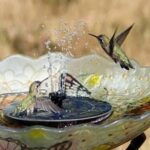Temperature for birds, birds with their remarkable diversity and adaptability, have successfully colonized almost every corner of our planet. Yet, despite their resilience, birds are not immune to the effects of temperature, especially when faced with extreme heat. In this guide, we delve into the crucial topic of how temperature affects our feathered friends, shedding light on the importance of understanding and mitigating its impact.
The relationship between temperature and birds is complex and multifaceted. Birds, like all warm-blooded creatures, have a preferred temperature range in which they thrive. Beyond this range, their physiological systems can become stressed, affecting everything from their metabolism to their behavior. This vulnerability becomes particularly pronounced during periods of soaring temperatures, such as heatwaves, which are becoming more frequent due to climate change.
To appreciate the significance of temperature for birds, one must consider the diverse array of species that populate our planet. Each bird species has its unique adaptations, preferences, and tolerance levels when it comes to temperature. Consequently, what may be comfortably warm for one species might be sweltering for another.
As responsible stewards of our environment, it is imperative that we grasp the nuances of this relationship. By doing so, we can make informed choices and take proactive measures to safeguard the well-being of our avian companions in the face of rising temperatures. In the sections that follow, we will explore the optimal temperature ranges for various bird species, signs of heat stress, and practical steps to create bird-friendly environments during hot weather. Together, we can ensure that birds continue to grace our skies and enrich our lives.
Birds and Hot Weather: How They Handle Heat

Birds have developed various strategies to cope with hot weather and soaring temperatures. First and foremost, they engage in behaviors like panting and gular fluttering, which help dissipate excess heat. Some species seek shade in trees or bushes, while others may bathe or soak themselves in water to cool down.
Additionally, birds may reduce their activity levels during the hottest parts of the day, conserving energy. Nesting birds often shield their eggs and chicks from direct sunlight. Furthermore, evolutionary adaptations, such as specialized feathers and anatomical features, aid in temperature regulation. Understanding these mechanisms is vital for ensuring bird well-being during scorching weather.
Efficient Cooling Mechanisms
Efficient cooling mechanisms are crucial for maintaining the well-being of birds in hot weather. Birds lack sweat glands and must rely on other methods to regulate their body temperature, which is typically higher than that of humans. Here are some key cooling mechanisms birds employ:
1. Panting: Birds often pant to cool down. This rapid, open-mouthed breathing helps expel heat through evaporation from their respiratory surfaces.
2. Peripheral Vasodilation: Birds can dilate blood vessels in their extremities, such as their legs and beaks, to increase blood flow to these areas, dissipating heat.
3. Wing Spreading: Some birds, like vultures, spread their wings to maximize heat loss through radiation when perched.
4. Bathing: Birds frequently bathe in water or dust to reduce their body temperature through evaporative cooling. Providing a birdbath in your yard can be beneficial.
5. Shade Seeking: Birds instinctively seek shade during hot weather, which reduces direct exposure to the sun’s heat.
6. Reduced Activity: During extreme heat, birds may reduce their activity levels, conserving energy and minimizing heat production.
Understanding these efficient cooling mechanisms can help bird enthusiasts and conservationists create bird-friendly environments that support avian well-being during hot temperatures.
Seeking Shade and Water
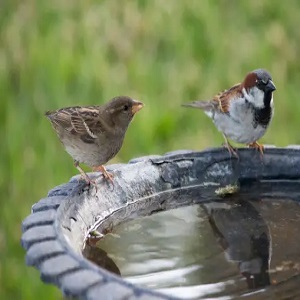
During scorching temperatures, birds are particularly vulnerable to heat stress. Providing ample shade and access to water is essential for their well-being. Natural shade from trees and shrubs can offer refuge, while strategically placing bird feeders and birdbaths in shaded areas can entice birds to stay cool.
Water sources are equally critical; clean, fresh water should be readily available for drinking and bathing. Bird baths, misters, and shallow dishes can all serve as effective water stations. Ensuring these provisions can help birds regulate their body temperature, stay hydrated, and reduce the risk of heat-related illnesses during sweltering days.
Adaptations for Survival
Adaptations for survival are the remarkable evolutionary adjustments that species develop to thrive in their specific environments. These adaptations can be structural, behavioral, or physiological, and they enable organisms to better cope with challenges posed by their surroundings.
Structural adaptations involve physical traits that enhance an organism’s survival chances. For instance, the thick fur of Arctic animals like polar bears insulates them in freezing temperatures. In contrast, behavioral adaptations refer to actions and habits that enhance survival.
Migratory birds travel thousands of miles to find food and suitable breeding grounds. Finally, physiological adaptations are internal changes that allow organisms to function optimally. Desert plants, such as cacti, have evolved water-storing mechanisms to survive in arid conditions.
Over time, adaptation is driven by natural selection, as individuals with advantageous traits are more likely to reproduce and pass those traits to their offspring. This process ensures that species remain well-suited to their environments, demonstrating the incredible capacity of life to adapt and endure in diverse ecosystems.
Hover Birds : An Important Guide To Unique Avian Flight [2023]
Providing a Comfortable Environment: Shade and Ventilation for Aviary Birds
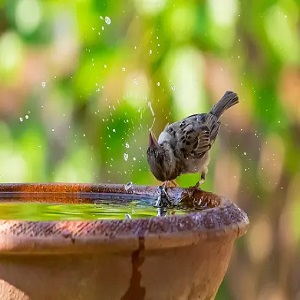
Creating a comfortable environment for aviary birds involves ensuring adequate shade and ventilation. Shade is crucial to protect birds from the scorching sun, preventing heat stress and dehydration.
Provide natural shade from trees or install artificial structures like umbrellas, awnings, or shade cloth. Adequate ventilation is equally important, as it helps maintain a fresh air supply, preventing heat buildup and reducing humidity. Proper airflow is essential to remove heat and stale air from the aviary.
Regularly clean and maintain ventilation systems to prevent the buildup of dust and debris. By prioritizing shade and ventilation, you can ensure a safe and comfortable living space for your aviary birds.
Shaded Areas: Protecting Birds from Direct Sunlight
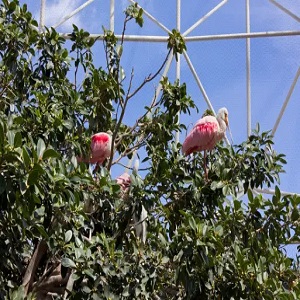
Shaded areas play a pivotal role in safeguarding birds from the detrimental effects of direct sunlight during hot weather. Birds lack sweat glands and are unable to regulate their body temperature through perspiration like humans. Instead, they rely on behavioral adaptations and seeking shelter to escape the scorching sun.
Providing shaded areas in your yard or garden can be a lifeline for our feathered friends. Trees, shrubs, pergolas, or specially designed birdhouses can create essential refuges from the sun’s intense rays. Natural vegetation not only provides cool spaces but also attracts insects and other food sources for birds, aiding their overall well-being.
Birds are intelligent creatures and will actively seek out shaded spots when temperatures rise. By landscaping with their needs in mind, you can ensure that they have access to safe and comfortable areas during the hottest parts of the day. Offering these sheltered zones in your outdoor space will contribute significantly to the health and vitality of the avian population in your area.
Proper Ventilation: Preventing Heat Buildup
Proper ventilation is a crucial aspect of creating a safe environment for birds during hot weather. Without adequate airflow, heat can accumulate in enclosed spaces, putting our feathered friends at risk of heat stress or even fatalities. Here are some key considerations:
- Natural Ventilation: Ensure that the aviary or bird enclosure has sufficient openings to allow for natural airflow. This can include windows, vents, or meshed walls. Position these openings strategically to encourage cross-ventilation, allowing fresh, cooler air to replace warm, stagnant air.
- Fans and Exhaust Systems: In areas with extreme heat, consider installing fans or exhaust systems to enhance ventilation. These mechanical solutions can help circulate air and dissipate heat effectively, especially in indoor aviaries or breeding facilities.
- Shade Structures: If your birds are outdoors, provide shade structures that protect them from direct sunlight. These shelters not only offer relief from high temperatures but also help reduce heat buildup within enclosures.
- Monitoring: Regularly check the temperature within the bird habitat to ensure it remains within safe limits. Use thermometers or temperature sensors to stay informed about any fluctuations.
By implementing proper ventilation measures, you can significantly reduce the risk of heat-related issues for your avian companions and create a more comfortable and safe environment for them during hot periods.
Promoting Bird Well-Being: Creating a Comfortable Environment
Promoting bird well-being involves creating a comfortable environment that caters to their specific needs. Providing natural shade through trees, shrubs, or birdhouses can shield them from excessive heat.
Fresh water sources, such as birdbaths or shallow dishes, help birds stay hydrated in hot weather. Offering a variety of bird-friendly food, like fruits and seeds, ensures they have access to nourishment.
Minimizing noise and disturbances near bird habitats allows them to rest undisturbed. Additionally, avoiding the use of pesticides and chemicals in your garden or yard helps protect their health. By considering these factors, you can play a vital role in maintaining a safe and comfortable environment for birds.
Hydration Matters: Importance of Water for Birds in Hot Weather
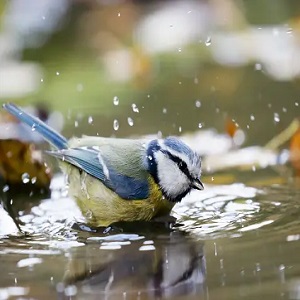
As temperatures rise during the scorching summer months, it’s not just humans who need to stay well-hydrated – our avian friends do too. Birds, like all creatures, rely on water for survival, and in hot weather, this vital resource becomes even more critical.
Water plays several essential roles in a bird’s life. Birds lack sweat glands, so they cool down by panting and drinking water. Adequate hydration is crucial to prevent heat stress and exhaustion, which can be life-threatening for these delicate creatures.
Additionally, water is essential for digestion. Birds often consume dry seeds and insects, and they need water to help break down their food efficiently. Without enough water, they may struggle to extract nutrients from their diet.
Providing a consistent source of clean, fresh water is a simple yet powerful way to support local bird populations during hot spells. Bird baths, bird feeders with built-in water trays, and even shallow dishes placed in gardens can all serve as reliable watering stations. Regularly replenishing these water sources is key, as birds depend on them for their well-being.
In conclusion, keeping our feathered friends hydrated is a fundamental act of kindness and conservation. By recognizing the importance of water for birds in hot weather and taking steps to ensure their access to it, we can contribute to the health and survival of these beautiful creatures in our ecosystems.
Recognizing Signs of Overheating in Birds
Recognizing signs of overheating in birds is crucial for their well-being. Look for panting, rapid breathing, open-beak posture, wings held away from the body, and reduced activity. Birds may also seek shade or water sources more frequently. Overheated birds may exhibit lethargy, drooping wings, and disorientation. If you notice these symptoms, it’s essential to take immediate action to help cool them down to prevent heat stress or even fatalities.
Rapid Breathing, Open-Mouthed Panting, or Wings Held Away from the Body
Rapid breathing, open-mouthed panting, and wings held away from the body are all indicative signs of heat stress in birds. When birds are exposed to excessively high temperatures, they struggle to regulate their body temperature efficiently. Rapid breathing and open-mouthed panting are common mechanisms birds employ to cool themselves down by expelling excess heat through their respiratory system.
Additionally, holding their wings away from the body allows for better air circulation to dissipate heat. Recognizing these signs is crucial, as prompt action can help prevent heat-related illnesses or fatalities in birds. Providing shade, fresh water, and a cooler environment is essential to alleviate their distress.
Lethargy, Loss of Appetite, or Drooping Wings

Lethargy, loss of appetite, and drooping wings are telltale signs of distress in birds. When a bird becomes lethargic, it becomes less active, often sitting in one place for extended periods. Loss of appetite is another concerning symptom, as birds are typically voracious eaters.
If a bird refuses food, it may be an early sign of illness or heat stress. Drooping wings can indicate weakness or discomfort, and birds may struggle to keep their wings properly aligned. Recognizing these symptoms promptly is crucial for providing timely care and potentially saving a bird’s life.
Observing Behavioral Changes Helps Identify Overheated Birds
Observing behavioral changes is a crucial method for identifying overheated birds and taking timely action to ensure their well-being. When birds are exposed to excessively high temperatures, they exhibit a range of observable behaviors that signal distress. These changes can include:
- Reduced Activity: Overheated birds may become lethargic and less active than usual. They may spend more time perched or sitting in shaded areas.
- Panting: Birds don’t sweat like humans, so they rely on panting to regulate their body temperature. Rapid, shallow breathing or open-mouthed panting is a clear sign of heat stress.
- Feather Fluffing: Birds may fluff up their feathers to increase air circulation, attempting to cool down their bodies.
- Seeking Shade: They instinctively seek out shaded areas, trees, or water sources to escape direct sunlight.
- Reduced Feeding: Overheated birds often have reduced appetites and may eat less or not at all.
- Restlessness: Some birds become restless, constantly moving or fidgeting as they try to find relief from the heat.
By paying attention to these behavioral changes, bird enthusiasts and caretakers can intervene promptly by providing shade, fresh water, and cooling options, helping overheated birds recover and stay safe in hot conditions.
Maintaining a Healthy Weight in Summer: Strategies to Keep Birds Cool

Maintaining a healthy weight in summer is crucial for birds’ well-being, as excessive heat can pose serious challenges to their survival. Here are some strategies to help birds stay cool and maintain a healthy weight during hot weather.
1. Provide Adequate Shade: Create shaded areas in your garden or outdoor space using trees, umbrellas, or awnings. This allows birds to escape the direct sun and lowers their body temperature.
2. Fresh Water Supply: Ensure a constant source of clean, fresh water. Birds need water not only for drinking but also for bathing, which helps them regulate their body temperature.
3. Water Features: Installing bird baths or small ponds can be beneficial. These features provide a cool oasis for birds to dip in and cool off.
4. Offer Cooling Foods: Provide foods with high water content, such as fruits (e.g., watermelon) and vegetables. These foods hydrate birds and contribute to their overall health.
5. Limit Feeding Times: Birds are most active during cooler parts of the day, such as early morning and late afternoon. Limit feeding during the heat of midday to avoid attracting them when it’s hottest.
6. Natural Shelter: Preserve and protect natural habitats, as trees and dense vegetation offer natural shade and shelter for birds.
7. Avoid Pesticides: Refrain from using pesticides and chemicals in your garden, as they can harm birds and disrupt their natural foraging habits.
8. Monitor for Heat Stress: Keep an eye out for signs of heat stress, such as panting, lethargy, or open-beaked breathing. If you notice these signs, provide immediate assistance.
By implementing these strategies, you can help birds stay cool and maintain a healthy weight during the sweltering summer months, ensuring their well-being and contributing to the preservation of local avian populations.
Determining the Threshold: What Temperature is Too Hot for Birds?
In the avian world, temperature can be a matter of life or death. This article explores the critical question of what temperature is too hot for birds, shedding light on the factors influencing their heat tolerance.
Discover the signs of heat stress and learn how to create a bird-friendly environment during scorching weather. By understanding the threshold at which high temperatures become dangerous, we can take proactive steps to protect our feathered friends.”
Species Variations and Acclimation Ability
Birds exhibit remarkable diversity in their ability to tolerate high temperatures. Different species have evolved to thrive in various climates, which influences their heat tolerance levels. This article delves into the fascinating world of species variations and acclimation ability when it comes to temperature.
Learn how certain birds, such as desert-dwelling species, have adapted to scorching conditions, while others prefer cooler environments. Explore the strategies birds employ to acclimate to rising temperatures, shedding light on their impressive ability to cope with heat stress. Understanding these variations is crucial for protecting our avian friends in a changing climate.”
High Temperatures: Above 90°F (32°C)
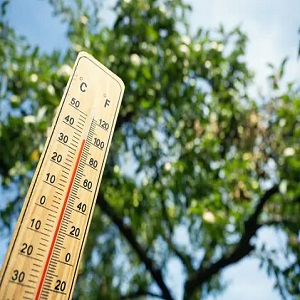
When temperatures soar above 90°F (32°C), birds face heightened risks of heat stress and health complications. This section explores the critical impacts of extreme heat on avian well-being. Birds’ ability to dissipate heat is limited, and prolonged exposure to such high temperatures can be lethal. Learn about the signs of distress in birds during scorching conditions, including panting, drooping wings, and reduced activity.
Discover practical tips for providing relief and protection to our feathered friends during heatwaves. From providing shade and fresh water to minimizing human disturbances, taking proactive measures becomes essential to safeguard birds when temperatures reach these extremes.”
Monitoring Local Weather Conditions
To ensure the safety and well-being of birds in your area, it’s crucial to stay informed about local weather conditions, especially during temperature extremes. This section highlights the significance of tracking weather forecasts and understanding their implications for avian life.
1. Temperature Predictions: Regularly check weather reports to stay aware of upcoming temperature spikes. Heatwaves can be particularly dangerous for birds, making it vital to know when such conditions are expected.
2. Heat Index: Pay attention to the heat index, which factors in humidity, as it provides a more accurate representation of how hot it feels. High humidity can exacerbate heat stress for birds.
3. Extreme Heat Warnings: Be alert for extreme heat warnings issued by local authorities. These alerts can serve as a valuable early warning system for you to take preemptive measures.
4. Shade and Water: Use weather information to plan ahead. Ensure that bird feeders and baths are well-shaded and that a constant supply of fresh water is available to help birds cool down.
By monitoring local weather conditions, you can proactively address temperature extremes and take steps to protect your local avian community from the adverse effects of hot weather.”
Birds Of Michigan: Discover The Top 33 Backyard Birds
Taking Action for Bird Safety
When temperatures rise to levels that could endanger our feathered friends, it’s essential to take prompt and effective action. This section outlines actionable steps you can take to ensure bird safety during hot weather.
1. Provide Shade: Set up natural or artificial shade in bird-friendly areas, offering a cool retreat from the scorching sun.
2. Fresh Water: Maintain a consistent supply of fresh, clean water in bird baths and feeders. Hydration is critical during heatwaves.
3. Reduce Human Disturbance: Minimize human activity near nesting areas to avoid causing unnecessary stress to birds.
4. Cooling Techniques: Explore various cooling techniques, such as misting systems or shallow water features, to help birds regulate their body temperature.
5. Heat Stress Intervention: If you observe signs of heat stress, contact local wildlife rescue organizations for guidance.
Taking these actions demonstrates our commitment to protecting and preserving our avian companions during challenging climatic conditions.”
FAQ’s:
Can birds withstand high temperatures like humans?
Birds have different heat tolerance levels than humans. This article explains the specific temperature ranges that are safe for various bird species.
What signs indicate that a bird is suffering from heat stress?
Learn to identify common signs of heat stress in birds, such as panting and lethargy, in this guide.
Are there certain bird species that are more vulnerable to heatwaves?
Discover how different bird species have varying levels of heat tolerance and which ones are particularly susceptible to extreme temperatures.
How can I create a bird-friendly environment during hot weather?
Find practical tips and recommendations for providing a safe and comfortable habitat for birds when temperatures rise.
Is climate change impacting bird safety in hotter temperatures?
Explore the relationship between climate change and its effects on bird habitats and safety, along with strategies to mitigate these impacts.
Vetpomedix.com

